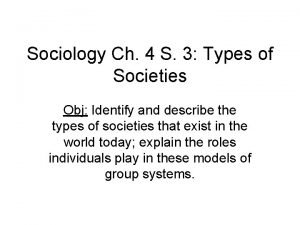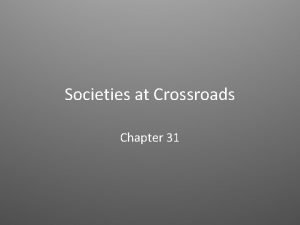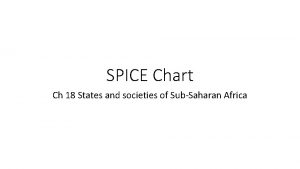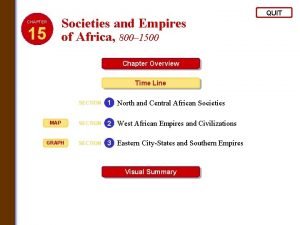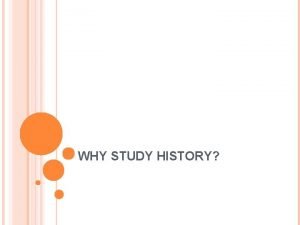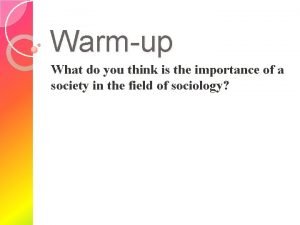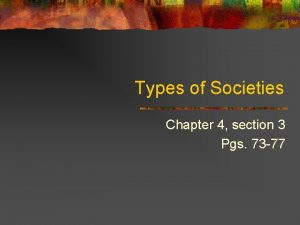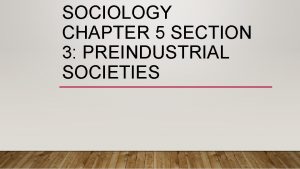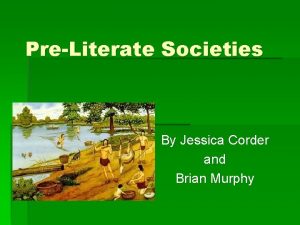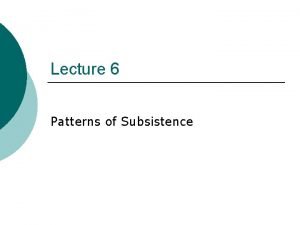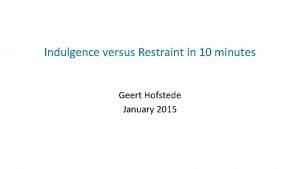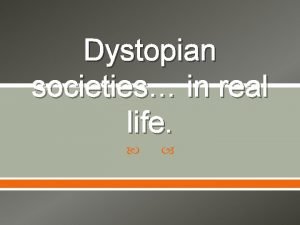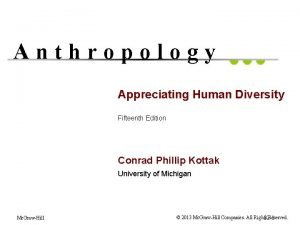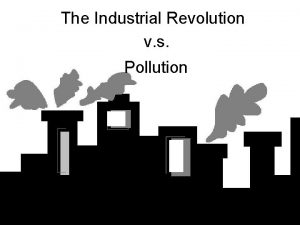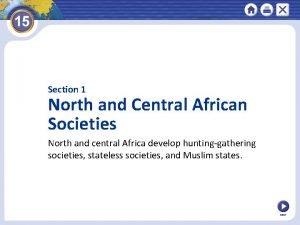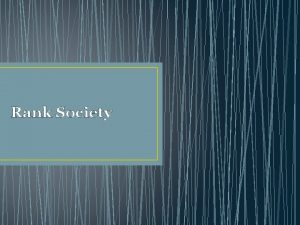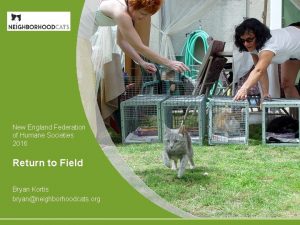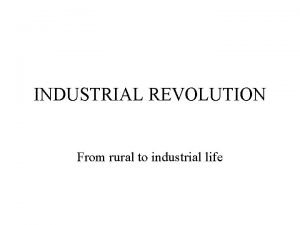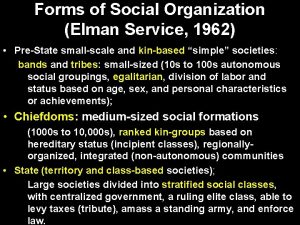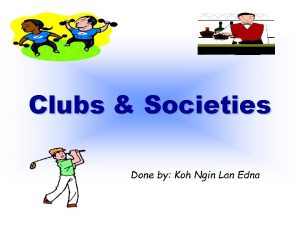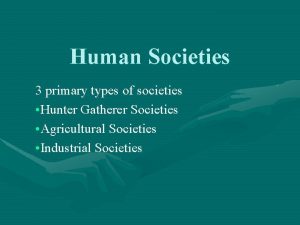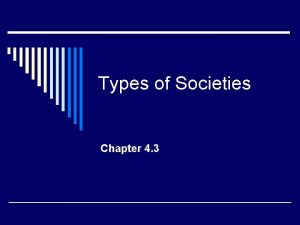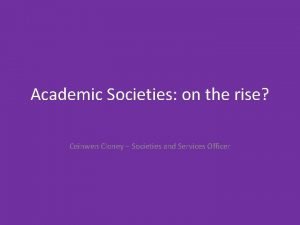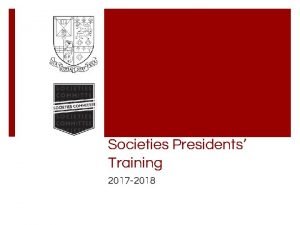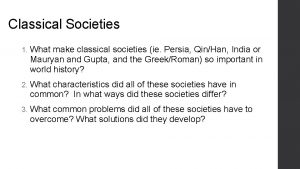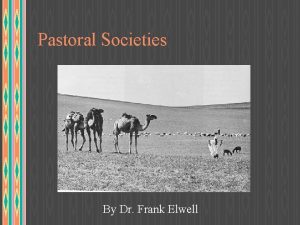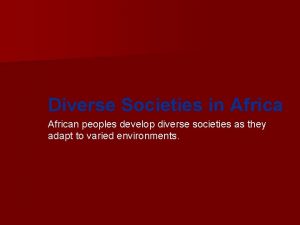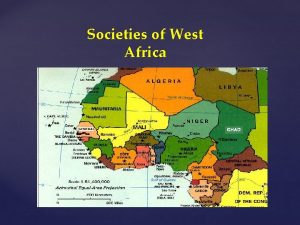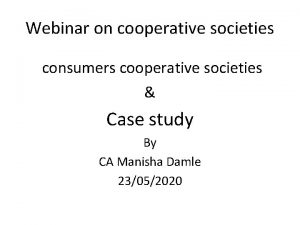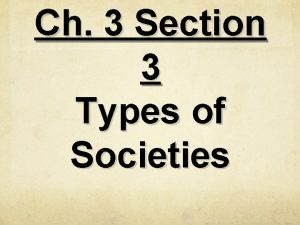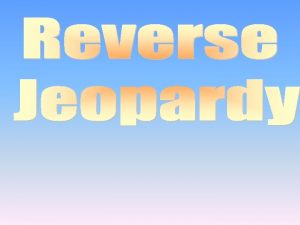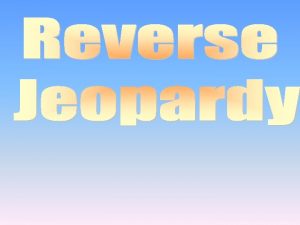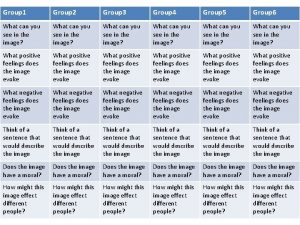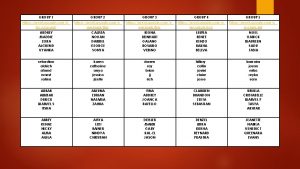Types of Societies Chapter 4 3 Group o
























- Slides: 24

Types of Societies Chapter 4. 3

Group: o. A set of people who interact on the basis of shared expectations and identity o. Societies: largest and most complex

Subsistence strategies o. The way society uses technology to meet the needs of members

Preindustrial Society o The main source of economic activity is FOOD PRODUCTION. o Preindustrial societies are divided into their method of producing food: n n Hunting and Gathering Pastoral Societies Horticultural Societies Agricultural Societies

Hunting and Gathering Society o The main form of food production consists of the collection of wild plants and hunting of wild animals.

Hunting Gathering Societies o Hunting and gathering societies consists of fewer than 60 people and rarely exceed 100. They are called “bands. ” http: //www. youtube. com/watch? v=mq. Ng. B 2 Fg 1 r. Y Dawn of Social Networks http: //www. youtube. com/watch? v=Itp. Hy. Drk. TM&list=LPRP 5 IZd 1 roo. Q&feature=plcp

Pastoral Societies o Rather than searching for food on a daily basis, members in a pastoral society rely on domesticated herd animals to meet their food needs.

Pastoral Societies o Division of labor- Because there are food surpluses, individuals within the group become specialized at specific economic tasks. EX- craft workers, producing tools, weapons, jewelry… These types of societies still exist, but are facing change: http: //www. youtube. com/watch? v=IWelr 7 E 3 j. NI

Horticultural Societies o Main source of food is fruits and vegetables grown in garden plots that have been cleared from the jungle or forest.

Horticultural Societies o Slash and burn method to raise crops: wild vegetation is cut and burned and the ash is used as fertilizer. Clip: http: //www. youtube. com/watch? v=lvwg 56 Ib. Wp. Y

Agricultural Societies o Animals are used to pull plows and till fields.

Agricultural Societies o Technology allows agriculturalists to plant more crops than is possible than when only human labor is used. o Higher crop yields = large populations o Sharp divisions in status – landowners (wealth and power) and peasants (workers). http: //www. youtube. com/watch? v=e. TB 2 p 2 I w. B 10

Industrial Societies o Emphasis shifts from production of food to manufactured goods. o Technology and the use of machines takes place of the farm laborer and those people work in production of goods.

Industrial Society o Industrial Society leads to urbanization – concentration of the population in cities. o In preindustrial society the family is the primary social institution, which provides production and education. o In industrial society production and education take place outside the family. The need for literacy in industrialized society leads to compulsory education.

Industrialization Continued o. One positive effect of industrialization is it brings freedom to compete for social position. (In preindustrial societies social statuses are ascribed). o. Statuses in industrial society becomes achieved.

Postindustrial Societies o. Economy is based on providing information and services. o. US 73% involved in providing goods and services, 2% involved in agriculture, 25% in the production of goods.

Changes from industrial to postindustrial societies o. Postindustrial society emphasis on the roles of science and education. o. Standard of living and quality of life improve as wages increase. o. Search for personal fulfillment takes on added importance.

Mechanical and Organic Solidarity Durkheim o Preindustrial societies are held together by mechanical solidarity, people share the same values and perform the same tasks, they become united in a common whole. o As the division of labor become more complex mechanic solidarity gives way to organic solidarity (refers to impersonal social relationships that rises from increased job specialization). http: //www. youtube. com/watch? v=3 Vwoih GP_i 8

Gemeinschaft (Tonnies) o German word meaning “community” o Society where most members know one another. o Activities center on family and community. o Examples: Preindustrial society or a rural small town or village.

Gesellschaft (Tonnies) o Refers to society in which most social relationships are based on NEED rather than emotion. o Relationships are impersonal and often temporary. o Individual’s goals are more important than the group’s. o Modern urban society.

Inside the Amish Church o http: //www. youtube. com/watch? v=wg 81 Vwd. RAVA&feature=related

The Outsider o http: //www. youtube. com/watch? v=Pm. Ym. JNs a. T-E Part 1 o http: //www. youtube. com/watch? v=z. VUQl. R 7 E MMc Part 2 o http: //www. youtube. com/watch? v=qihi. Ksz. P 53 Y Part 3

o http: //www. youtube. com/watch? v=1 Vp 5 d ls 7 p 3 c&feature=related The outsiders #6 o http: //www. youtube. com/watch? v=VRbrd L 9 n 3 GM&feature=related

o http: //www. youtube. com/watch? v=Pcm. E Sjcmrz. M&feature=related Amish World's Squarest Teenagers part 1 o http: //www. youtube. com/watch? feature= endscreen&v=_Nb. R 36 Anp. X 0&NR=1 Part 12
 Pastoral society characteristics
Pastoral society characteristics Chapter 31 societies at crossroads outline
Chapter 31 societies at crossroads outline Great zimbabwe spice chart
Great zimbabwe spice chart Chapter 15 societies and empires of africa
Chapter 15 societies and empires of africa History help us understand people and societies
History help us understand people and societies Horticultural society characteristics
Horticultural society characteristics Simple horticultural societies
Simple horticultural societies Subsists primarily by raising animals
Subsists primarily by raising animals Pre-literate society examples
Pre-literate society examples Simple horticultural societies
Simple horticultural societies Examples of indulgence vs restraint
Examples of indulgence vs restraint Real life dystopian societies in history
Real life dystopian societies in history Diverse societies in africa
Diverse societies in africa Pastoral societies
Pastoral societies In nonindustrial societies artists
In nonindustrial societies artists What is pre-industrial societies
What is pre-industrial societies North and central african societies
North and central african societies Rank societies
Rank societies New england federation of humane societies
New england federation of humane societies Domestic system
Domestic system Elman service classification of societies
Elman service classification of societies Federation of european neuroscience societies
Federation of european neuroscience societies Effas
Effas Refreshments trading account
Refreshments trading account Secret societies in the bible
Secret societies in the bible
